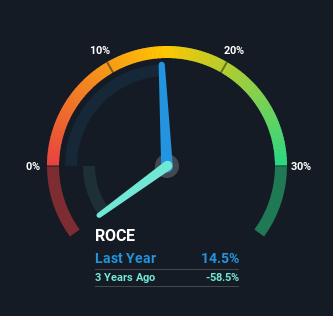What underlying fundamental trends can indicate that a company might be in decline? When we see a declining return on capital employed (ROCE) in conjunction with a declining base of capital employed, that's often how a mature business shows signs of aging. This indicates to us that the business is not only shrinking the size of its net assets, but its returns are falling as well. On that note, looking into Boer Power Holdings (HKG:1685), we weren't too upbeat about how things were going.
Return On Capital Employed (ROCE): What is it?
For those who don't know, ROCE is a measure of a company's yearly pre-tax profit (its return), relative to the capital employed in the business. The formula for this calculation on Boer Power Holdings is:
Return on Capital Employed = Earnings Before Interest and Tax (EBIT) ÷ (Total Assets - Current Liabilities)
0.15 = CN¥69m ÷ (CN¥1.3b - CN¥825m) (Based on the trailing twelve months to June 2021).
Therefore, Boer Power Holdings has an ROCE of 15%. In absolute terms, that's a satisfactory return, but compared to the Electrical industry average of 9.4% it's much better.
View our latest analysis for Boer Power Holdings

While the past is not representative of the future, it can be helpful to know how a company has performed historically, which is why we have this chart above. If you'd like to look at how Boer Power Holdings has performed in the past in other metrics, you can view this free graph of past earnings, revenue and cash flow.
So How Is Boer Power Holdings' ROCE Trending?
The trend of returns that Boer Power Holdings is generating are raising some concerns. Unfortunately, returns have declined substantially over the last five years to the 15% we see today. On top of that, the business is utilizing 78% less capital within its operations. The fact that both are shrinking is an indication that the business is going through some tough times. Typically businesses that exhibit these characteristics aren't the ones that tend to multiply over the long term, because statistically speaking, they've already gone through the growth phase of their life cycle.
On a separate but related note, it's important to know that Boer Power Holdings has a current liabilities to total assets ratio of 63%, which we'd consider pretty high. This effectively means that suppliers (or short-term creditors) are funding a large portion of the business, so just be aware that this can introduce some elements of risk. While it's not necessarily a bad thing, it can be beneficial if this ratio is lower.
The Key Takeaway
In summary, it's unfortunate that Boer Power Holdings is shrinking its capital base and also generating lower returns. This could explain why the stock has sunk a total of 90% in the last five years. That being the case, unless the underlying trends revert to a more positive trajectory, we'd consider looking elsewhere.
Boer Power Holdings does come with some risks though, we found 5 warning signs in our investment analysis, and 1 of those shouldn't be ignored...
If you want to search for solid companies with great earnings, check out this free list of companies with good balance sheets and impressive returns on equity.
Valuation is complex, but we're here to simplify it.
Discover if Boer Power Holdings might be undervalued or overvalued with our detailed analysis, featuring fair value estimates, potential risks, dividends, insider trades, and its financial condition.
Access Free AnalysisHave feedback on this article? Concerned about the content? Get in touch with us directly. Alternatively, email editorial-team (at) simplywallst.com.
This article by Simply Wall St is general in nature. We provide commentary based on historical data and analyst forecasts only using an unbiased methodology and our articles are not intended to be financial advice. It does not constitute a recommendation to buy or sell any stock, and does not take account of your objectives, or your financial situation. We aim to bring you long-term focused analysis driven by fundamental data. Note that our analysis may not factor in the latest price-sensitive company announcements or qualitative material. Simply Wall St has no position in any stocks mentioned.
About SEHK:1685
Boer Power Holdings
An investment holding company, designs, manufactures, and sells electrical distribution equipment in the People’s Republic of China.
Adequate balance sheet with acceptable track record.
Market Insights
Community Narratives



